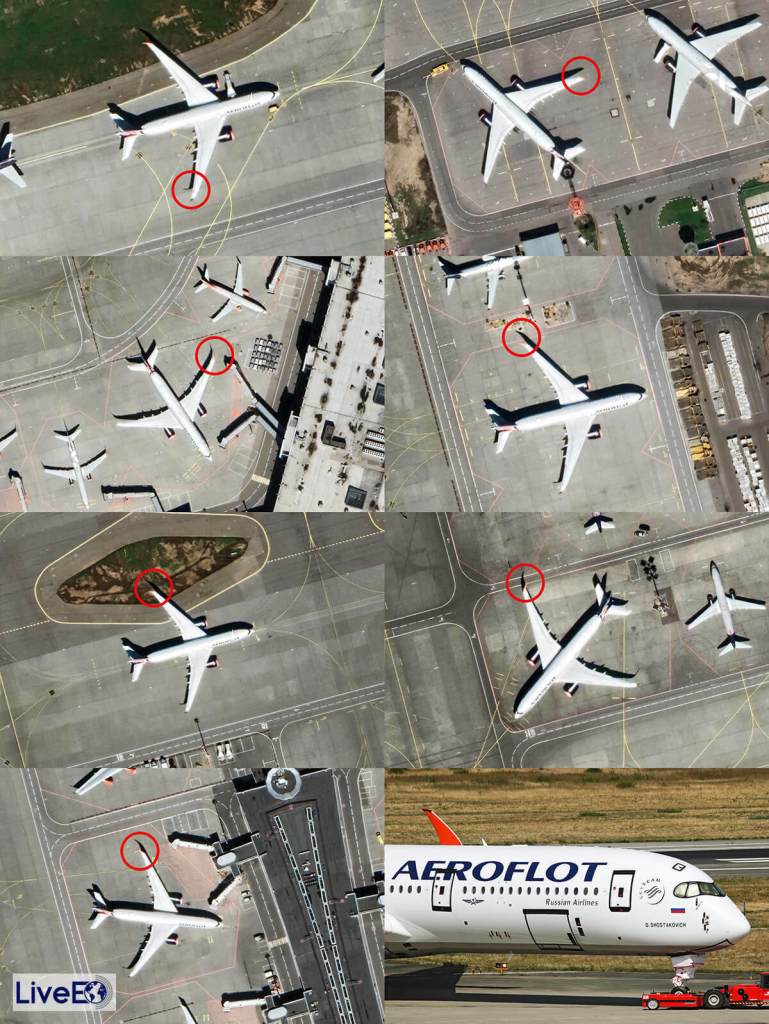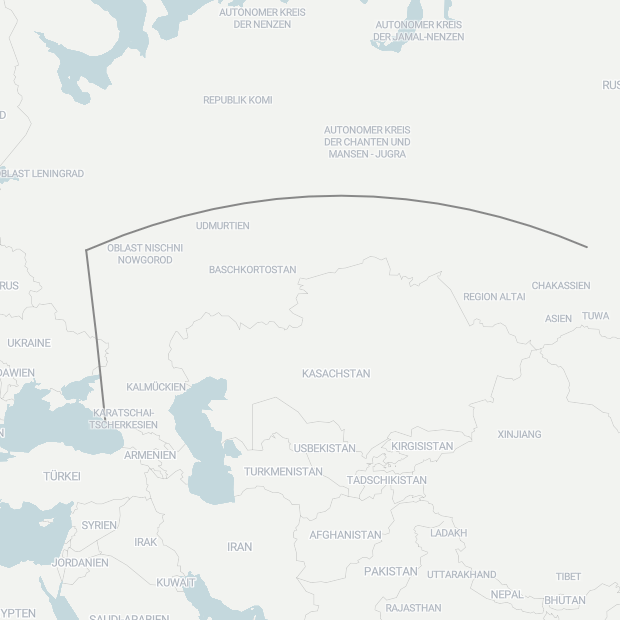While airports in Europe are groaning under the rush of travelers this summer, the latest satellite images at Moscow’s main airport Sheremetyevo reveal a different drama: since the Ukraine war, it has increasingly become an aircraft graveyard.
“Economy from above” is a collaboration between WirtschaftsWoche and LiveEO. This is a translation of the original article written in German by “Rüdiger Kiani-Kreß and Thomas Stölzel“. Access the original article here.
In March 2020, Vitaly Saveliev was still euphoric. “With the world’s most modern long-haul aircraft, as of today we are raising our service to a new level and gaining new opportunities in the highly competitive long-haul business,” boasted the then head of Russia’s state-owned Aeroflot airline as he welcomed the first Airbus A350 at Moscow’s largest airport, Sheremetyevo. Eleven planes were to follow by the end of the year, and seven more by 2023. They were to fly to New York, Osaka, Singapore or Havana, making Aeroflot a top player, especially in the then still rapidly growing traffic between Europe and Asia.
Today, the 68-year-old is Russia’s transport minister – and not much is left of his ideas, as recent satellite images from LiveEO show.
Sheremetyevo survived the Corona period without any problems. Traffic only dropped by about half. But now, when airports in the rest of Europe are running at full speed again and repeatedly exceed their capacity limits during the vacation season, only the two in the north and the one for business travelers are open at the airport in Moscow, which is designed for up to 60 million travelers. “Of the three passenger terminals D, E and F in the south of the airport, the last one has also been completely closed since mid-March,” reports an insider.

According to a recent photo, there are plenty of planes at the gates. But they only appear to be ready to take on passengers. A closer look shows that the jetways have been retracted. A photo taken a week earlier shows no change. A clear sign that the terminals are shut down.
Changes can be seen here and there, and some aircraft were moved to a different position between the two shots. However, experts explain this by saying that the airlines have to move their equipment regularly because this is the only way to keep the landing gears mobile and the aircraft roadworthy.
At least two of the seven new Airbus A350 jets of the Russian state carrier Aeroflot are also parked at the gates in the south. This is shown by a detailed analysis of the photographs. For this purpose, WirtschaftsWoche measured the aircraft and examined them for typical features such as the upwardly curved wingtips.
Neither Airbus nor other aircraft experts were able to identify the planes with one hundred percent certainty from the current images. However, data from Flightradar24 show that of seven Aeroflot aircraft with current official registration codes RA-73151-7, three have not taken off for at least 90 days. In fact, the newest one, with Airbus serial number 466 and original registration VP-BYF, has not carried a paying passenger since Aeroflot took it out of the factory in Toulouse, southern France, on Feb. 24 this year, the day of the Russian invasion of Ukraine.
.jpeg)
.jpeg)
The fact that these high-tech jets, which other airlines are currently longing for, are simply sitting around points to a hidden drama. A few days ago, the daily newspaper Izvestia, which is considered to be close to the state, reported that Transport Minister Vitaly Saveliev is having the rules examined under which the country’s airlines can use their parked aircraft as spare parts donors. A regulation is expected to come into force at the beginning of next year, he said. However, as insiders confirm to WirtschaftsWoche, cannibalization is already in full swing. And one of the first aircraft is an A350. “The first of these marvels, which cost around 300 million, has already been cannibalized,” the insider comments. “And it looks like the other two, currently parked permanently, will soon get their turn as well.”
The reason for this cruel act from the point of view of aircraft fans is pure necessity. Since the Western states largely banned the supply of aircraft and their components in the wake of the invasion of Ukraine, spare parts have been in short supply. That’s because, unlike consumer goods, the sophisticated equipment is subject to strict export and whereabouts controls. “We always know pretty much where the parts of new models are, especially,” shares an Airbus manager. Therefore, it is difficult to circumvent the embargo via a kind of black market.
These sanctions hit Aeroflot and other Russian airlines hard. According to statistics from the Russian Ministry of Transport, 90 percent of their passengers have been carried in Western-built aircraft. Officially, 470 of the 1287 registered civil aircraft come from domestic factories – that is one third. But because the Tupolevs and Ilyushins are smaller and older, they are used less frequently.
In addition, some of the models manufactured in the country, such as the SSJ100 superjet from Sukhoi, cannot do without Western parts, for example for the engines. According to a report by the state news agency Interfax, without new rules on spare parts, 300 of the 800 or so foreign jets currently still in service would no longer be operational by2025 at the latest. This is mainly due to strict safety regulations. In order to avoid risks, an aircraft is considered unfit for takeoff if only one of the hundreds of thousands of important parts no longer functions, even if there are several of them, such as an on-board computer.
The cannibalized parts are a good substitute there. But even that only applies to a limited extent. With the innards of the three parked A350s, the four active siblings can get by for up to three years in the best case, if the jets are only used a few hours a day, estimates Hamburg aviation expert Heinrich Großbongardt. “But that only succeeds if nothing major happens. One bottleneck in particular is wear-intensive components such as tires, brake pads and brake discs.”

But it is not only the A350s destined for cannibalization that await a sad fate. The four jets still in use are also flying far below their capabilities. They are currently flying almost exclusively on the Moscow-Krasnoyarsk and Moscow-Sochi routes – both destinations where Aeroflot can comfortably fly there in the morning and back in the afternoon. Sochi has a dual function. On the one hand, the Black Sea metropolis is one of the most important flight destinations for Russian tourists since others in Europe are no longer accessible. On August 12 alone, there were 64 flights from Moscow’s three largest airports to the seaside resort, which is now considered a kind of Russian Ballermann.
{{inline}}
But the venue of the 2014 Winter Olympics now has another function: it is Russia’s only hub for flights abroad. It is operated almost exclusively by the small Russian-made superjets. These have a limited range, but thanks to Sochi’s peripheral location in the country, they can reach many places such as Dubai or Delhi. This would not be possible from Moscow or St. Petersburg. So the few foreign travelers are forced to change planes in Sochi.
The fact that Russian airlines are no longer using their Airbus and Boeing jets with the significantly higher ranges is a consequence of the sanctions. On the one hand, they risk losing the aircraft: This is because after the embargo began, the airlines did not return the aircraft to Western leasing companies as required. Now they risk lessors seizing and reclaiming them when they fly abroad under a local court order. “You can be sure that the lessors have installed alerts on FlightAware or Flightradar24, and they’ll get their lawyers on the job as soon as one of them shows up beyond Russian airspace,” Grossbongardt explains.
With a good chance of success. In Egypt and Sri Lanka, two Russian aircraft were almost permanently detained. In the end, they were able to take off again. But it was a close call. “It was probably more due to the fact that, on the government’s instructions, a few more convolutions were added at short notice to the already convoluted legal process,” speculates an insider. This will probably not happen again in the future, because the EU and the USA have threatened consequences, says a leasing manager: “Now, even in the few countries that are still friendly with Russia, it is no longer certain that all courts will bow to political pressure from the Kremlin,” says the aircraft financier.
But even if the leasing companies do not complain about the jets, the sanctions would take effect. Russian airlines could not be sure that they would get all the necessary spare parts in the event of a breakdown abroad. “And then it’s already the end of the road if the thing has a flat tire,” notes Großbongardt. Even if parts can still be flown to widely used models such as the Boeing 737 or an Airbus A320. With wide-body aircraft of the caliber of the Boeing 777 and the A350, logistics can be very difficult.
On the Medium-Haul Route
The current routes of Aeroflot-A350

At first glance, it is astonishing that Aeroflot is now burning up the showpiece A350 on a route that, like the similarly long Frankfurt-Madrid route, is typical for medium-haul aircraft a la A320. It would make much more sense to operate the aircraft from Moscow to Vladivostok, a route roughly as long as Frankfurt-New York. But the measure is designed to conserve the A350s. “If the planes only fly four hours a day, they last much longer and need fewer spare parts,” notes an insider.
Long-haul routes within Russia are now flown up to five times a day in each direction by large Boeing 777-300ERs. If they can no longer take off, this would not only have economic consequences in a centralized state like Russia, but would also affect the political cohesion of the huge country. After all, the Trans-Siberian Railway takes almost seven whole days according to the current timetable.
Thus, the former Sheremetyevo hub is likely to remain a parking lot and spare parts dispenser for a while yet. More than a dozen jumbo jets of the Russian cargo line AirBridgeCargo, for example, are parked around the southern terminals. Flightradar24 data shows that none of the Boeing-747 aircraft have taken off in recent months. The carrier flew regularly to Leipzig/Halle Airport before the war, and even operated a maintenance terminal there.







